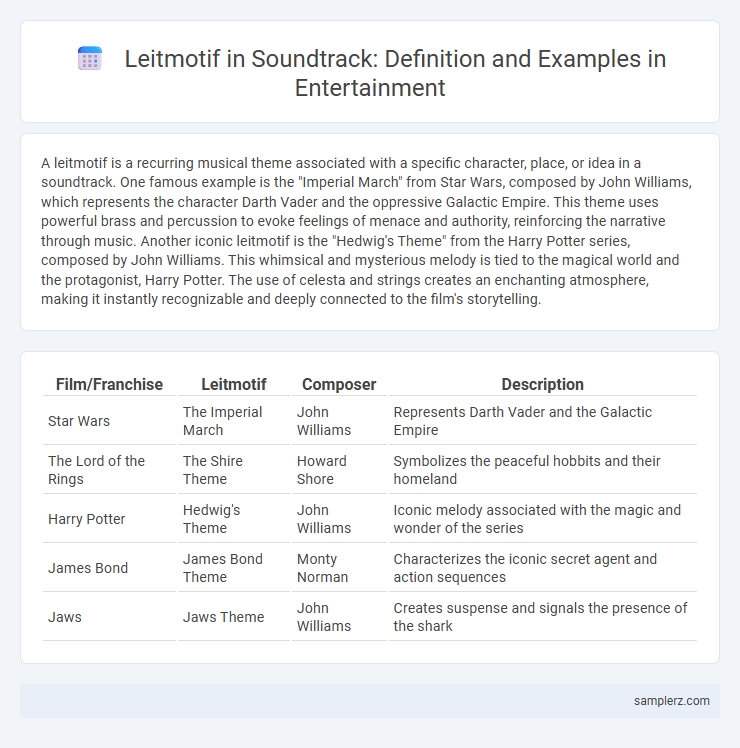A leitmotif is a recurring musical theme associated with a specific character, place, or idea in a soundtrack. One famous example is the "Imperial March" from Star Wars, composed by John Williams, which represents the character Darth Vader and the oppressive Galactic Empire. This theme uses powerful brass and percussion to evoke feelings of menace and authority, reinforcing the narrative through music. Another iconic leitmotif is the "Hedwig's Theme" from the Harry Potter series, composed by John Williams. This whimsical and mysterious melody is tied to the magical world and the protagonist, Harry Potter. The use of celesta and strings creates an enchanting atmosphere, making it instantly recognizable and deeply connected to the film's storytelling.
Table of Comparison
| Film/Franchise | Leitmotif | Composer | Description |
|---|---|---|---|
| Star Wars | The Imperial March | John Williams | Represents Darth Vader and the Galactic Empire |
| The Lord of the Rings | The Shire Theme | Howard Shore | Symbolizes the peaceful hobbits and their homeland |
| Harry Potter | Hedwig's Theme | John Williams | Iconic melody associated with the magic and wonder of the series |
| James Bond | James Bond Theme | Monty Norman | Characterizes the iconic secret agent and action sequences |
| Jaws | Jaws Theme | John Williams | Creates suspense and signals the presence of the shark |
Iconic Leitmotifs in Film History
The iconic leitmotif in film history is John Williams' "Imperial March" from Star Wars, which symbolizes Darth Vader's ominous presence and has become a cultural touchstone for villainy. Another classic example is Howard Shore's haunting "The Lord of the Rings" motifs, which effectively convey character identities and thematic elements across the trilogy. Ennio Morricone's distinctive whistles and harmonicas in The Good, the Bad and the Ugly enhance the narrative by musically representing the characters' moral complexity and the film's Western setting.
Famous Leitmotifs in TV Series Soundtracks
The "Game of Thrones" main theme, composed by Ramin Djawadi, stands as one of the most iconic leitmotifs in TV series soundtracks, symbolizing the epic struggle for power in Westeros. In "Stranger Things," Kyle Dixon and Michael Stein use a nostalgic, synth-driven leitmotif to evoke the 1980s setting and supernatural mystery. The "Westworld" theme by Ramin Djawadi features a haunting piano leitmotif that reflects the show's intricate blend of artificial consciousness and human emotions.
Memorable Leitmotifs in Video Game Music
The iconic "Zelda's Lullaby" in The Legend of Zelda series exemplifies a memorable leitmotif that instantly evokes the game's mystical atmosphere. Nobuo Uematsu's "Aerith's Theme" from Final Fantasy VII conveys deep emotional resonance through its recurring melodic lines. These leitmotifs create strong auditory associations, enhancing narrative immersion and player connection in video game music.
Leitmotifs Defining Movie Characters
Leitmotifs in movie soundtracks serve as powerful auditory symbols that define and distinguish characters, such as John Williams' heroic theme for Luke Skywalker in Star Wars, which encapsulates his journey and valor. Hans Zimmer's use of the rising motif in Inception creates a tense and immersive atmosphere closely tied to Cobb's complex psyche. These recurring musical phrases deepen audience connection by reinforcing character identities and emotional arcs throughout the narrative.
Leitmotifs That Shape Cinematic Worlds
Leitmotifs in soundtracks, such as John Williams' iconic theme for "Star Wars," serve as powerful musical identifiers that deepen character and narrative engagement. Howard Shore's use of the Ring theme in "The Lord of the Rings" trilogy creates an enduring emotional connection that guides viewers through complex storytelling. These recurring musical phrases shape cinematic worlds by reinforcing themes and enhancing the immersive experience of film audiences.
Composer’s Signature Leitmotifs in Soundtracks
John Williams' signature leitmotifs in soundtracks, such as the instantly recognizable two-note motif in "Jaws" and the heroic theme in "Star Wars," showcase his mastery in creating memorable musical identities for characters and settings. Hans Zimmer's use of repetitive, evolving motifs in films like "Inception" and "The Dark Knight" exemplifies his innovative approach to building tension and emotional depth. Howard Shore's intricate leitmotifs in "The Lord of the Rings" trilogy weave complex musical narratives that enhance the epic storytelling and character development throughout the series.
Leitmotifs in Animated Film Scores
Leitmotifs in animated film scores create memorable, recurring musical themes that enhance character identity and narrative development, such as John Williams' iconic "Imperial March" motifs in Star Wars: Clone Wars. Disney's use of leitmotifs in films like The Lion King assigns specific melodies to characters, like Simba's heroic theme, reinforcing emotional connections. These thematic elements anchor storytelling, making animated features more immersive and emotionally resonant through consistent musical signatures.
Emotional Impact of Leitmotifs in Music
Leitmotifs in soundtracks, such as Darth Vader's "Imperial March" by John Williams, profoundly enhance emotional resonance by instantly evoking character presence and thematic tension. This recurring musical theme triggers audience recognition, heightening suspense and deepening character connection. The strategic use of leitmotifs intensifies emotional engagement by reinforcing narrative elements through music memory association.
Leitmotifs Enhancing Storytelling in Media
Leitmotifs serve as powerful tools in soundtracks, linking specific melodies to characters, locations, or themes, thereby enhancing narrative cohesion in films such as "Star Wars" and "The Lord of the Rings." John Williams' iconic "Imperial March" immediately evokes Darth Vader's presence, while Howard Shore's motifs in "The Lord of the Rings" encapsulate the essence of Middle-earth's diverse cultures. These recurring musical themes deepen audience engagement by reinforcing emotional and story elements throughout the media experience.
Evolution of Leitmotifs in Contemporary Soundtracks
Leitmotifs in contemporary soundtracks, such as John Williams' iconic themes for the Star Wars saga, enhance character identity and narrative cohesion through recurring musical phrases. Hans Zimmer's use of evolving leitmotifs in films like Inception adapts thematic elements to reflect character development and shifting plot dynamics. Modern composers increasingly integrate complex leitmotif variations, blending orchestral and electronic sounds to evoke emotional depth and audience engagement.

example of leitmotif in soundtrack Infographic
 samplerz.com
samplerz.com